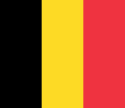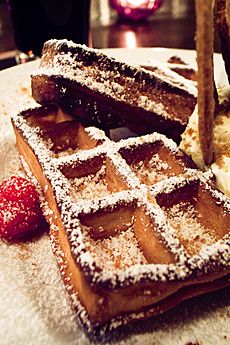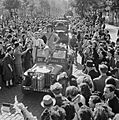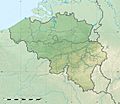Belgium facts for kids
Quick facts for kids
Kingdom of Belgium
|
|
|---|---|
|
Motto: Eendracht maakt macht (Dutch)
L'union fait la force (French) Einigkeit macht stark (German) (English: "Unity makes strength")
|
|
|
Anthem:
La Brabançonne |
|
|
Location of Belgium (dark green)
– on the European continent (light green & dark grey) |
|
| Capital | City of Brussels 50°51′N 4°21′E / 50.850°N 4.350°E |
| Largest city | Brussels-Capital Region |
| Official languages | |
| Ethnic groups
(2024)
|
|
| Religion
(2021)
|
|
| Demonym(s) | |
| Government | Federal parliamentary constitutional monarchy |
|
• Monarch
|
Philippe |
| Bart De Wever | |
| Legislature | Federal Parliament |
| Senate | |
| Chamber of Representatives | |
| Establishment | |
| 1789–1790 | |
|
• United Belgian States
|
1790 |
|
• Provisional Government of Belgium
|
1814–1815 |
| 1815–1839 | |
| 25 August 1830 | |
|
• Declared
|
4 October 1830 |
| 19 April 1839 | |
| 1970 | |
| Area | |
|
• Total
|
30,689 km2 (11,849 sq mi) (136th) |
|
• Water (%)
|
0.64 (2022) |
| Population | |
|
• 2024 census
|
|
|
• Density
|
383/km2 (992.0/sq mi) (22nd) |
| GDP (PPP) | 2024 estimate |
|
• Total
|
|
|
• Per capita
|
|
| GDP (nominal) | 2024 estimate |
|
• Total
|
|
|
• Per capita
|
|
| Gini (2022) | ▲ 24.9 low |
| HDI (2022) | very high · 12th |
| Currency | Euro (€) (EUR) |
| Time zone | UTC+1 (CET) |
|
• Summer (DST)
|
UTC+2 (CEST) |
| Driving side | right |
| Calling code | +32 |
| ISO 3166 code | BE |
| Internet TLD | .be and .eu |
|
|
Belgium, officially known as the Kingdom of Belgium, is a country in Western Europe. It is a federal state, meaning it has different levels of government. Belgium covers an area of about 30,528 square kilometers (11,849 square miles). Around 11 million people live there.
Belgium was one of the first countries to join the European Union. Its main office is in Brussels, which is also the capital city of Belgium. Many other important groups, like NATO, are also based in Brussels.
Belgium has three main regions:
- Flanders: This is the northern part of Belgium. Most people here, called the Flemish people, speak Dutch.
- Wallonia: This is the southern part of Belgium. Most people here, called the Walloons, speak French. There's also a small area near Germany where people speak German.
- The Brussels-Capital Region: This region is in the middle of the country. It is surrounded by Flanders. Brussels used to be Dutch-speaking. Today, most people speak French, but some still speak Dutch.
About 60% of people in Belgium speak Dutch. Around 39% speak French, and 1% speak German. Because of these different language groups, Belgium has a special and sometimes complex government system.
Contents
History of Belgium
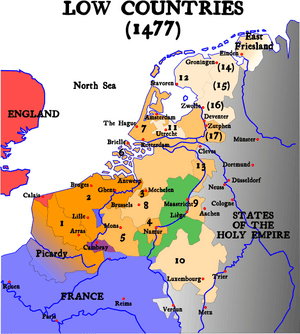
The name 'Belgium' comes from Gallia Belgica. This was a Roman province in the northern part of Gaul. Before the Romans arrived around 100 BC, the Belgae lived there. They were a mix of Celtic and Germanic peoples.
Later, Germanic tribes called the Frankish took over the area. This happened in the 5th century. The region became part of the Carolingian Empire in the 8th century. In 843, the Treaty of Verdun split the empire. This divided the region into parts that were linked to either the King of France or the Holy Roman Emperor.
Many of these smaller areas joined together. They formed the Burgundian Netherlands in the 14th and 15th centuries.
Becoming a Country
The Eighty Years' War (1568–1648) split the Low Countries. The northern part became the Dutch Republic. The southern part, which is now mostly Belgium, was ruled by the Spanish and Austrian Habsburg families.
In 1794, the Low Countries became part of the French First Republic. This ended Austrian rule. After the French Empire ended in 1815, the Low Countries joined to form the United Kingdom of the Netherlands.
However, the Belgian Revolution happened in 1830. Belgium became an independent country. Leopold I became the first king on July 21, 1831. This day is now celebrated as Belgium's National Day.
Colonial History and World Wars
In 1885, King Leopold II of Belgium gained control of the Congo Free State. This was his personal property, not Belgium's. Many people in Congo suffered greatly. They were forced to work, especially to collect rubber. King Leopold II became very rich.
In 1908, the Belgian government took control of the colony. It was renamed the Belgian Congo. However, the local people continued to face violence.
Germany invaded Belgium in 1914, starting World War I. Belgium suffered a lot during the war. After World War I, Belgium gained control of Ruanda-Urundi (now Rwanda and Burundi). Also, the areas of Eupen and Malmedy were added to Belgium in 1925.
Germany invaded Belgium again in 1940. The country was under German control until 1944. After World War II, King Leopold III left his throne in 1951. Some people thought he had helped the Germans during the war.
In 1960, the Belgian Congo became independent. Ruanda-Urundi also gained freedom two years later. Belgium became a founding member of NATO, a military alliance.
Government and Politics
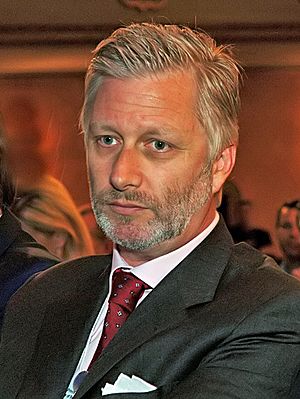
Since 1993, Belgium has been a federal state. This means power is shared between the central government and regional governments. It is divided into three regions and three communities.
The three regions are:
- Brussels-Capital Region
- Flemish Region (also called Flanders)
- Walloon Region (also called Wallonia)
The three communities are based on language:
- Flemish Community (Dutch-speaking)
- French Community of Belgium (French-speaking)
- German-speaking Community of Belgium (German-speaking)
Belgium has a constitutional monarchy. This means it has a monarch (a king or queen), but the monarch does not rule the country. The country is run by an elected democratic government.
The government in Belgium is elected by the people. Sometimes, it can take a long time to form a government after an election. For example, between 2010 and 2011, Belgium had no official government for a while. Both Flanders and Wallonia also have their own regional governments. There is a movement in Flanders that wants more independence.
Geography of Belgium
Belgium shares borders with France, Germany, Luxembourg, and the Netherlands. Its total area is about 33,990 square kilometers. The land area is 30,528 square kilometers.
Belgium has three main types of land:
- The coastal plain is in the north-west. It has many sand dunes and flat, reclaimed land called polders.
- The central plateau is a gently rising landscape further inland. It has fertile valleys and hills with forests.
- The Ardennes uplands are in the south-east. This area is rougher and rocky, with caves and narrow valleys. The highest point in Belgium, Signal de Botrange, is here at 694 meters (2,277 feet).
Provinces of Belgium
Belgium is divided into three Regions. The Flanders and Wallonia regions are further divided into provinces. The Brussels-Capital Region is not part of any province.
| Province | Dutch name | French name | Capital | Largest city | Area (km²) |
Population |
|---|---|---|---|---|---|---|
| Antwerp | Antwerpen | Anvers | Antwerp (Dutch: Antwerpen) (French: Anvers) |
Antwerp (Dutch: Antwerpen) (French: Anvers) |
2,860 | 1,682,683 |
| East Flanders | Oost-Vlaanderen | Flandre-Orientale | Ghent (Dutch: Gent) (French: Gand) |
Ghent (Dutch: Gent) (French: Gand) |
2,982 | 1,389,199 |
| Flemish Brabant | Vlaams-Brabant | Brabant flamand | Leuven (French: Louvain) |
Leuven (French: Louvain) |
2,106 | 1,037,786 |
| Hainaut | Henegouwen | Hainaut | Mons (Dutch: Bergen) |
Charleroi | 3,800 | 1,294,844 |
| Liège | Luik | Liège | Liège (Dutch: Luik) (German: Lüttich) |
Liège (Dutch: Luik) (German: Lüttich) |
3,844 | 1,047,414 |
| Limburg | Limburg | Limbourg | Hasselt | Hasselt | 2,414 | 805,786 |
| Luxembourg | Luxemburg | Luxembourg | Arlon (Dutch: Aarlen) (German: Arel) |
Bastogne (Dutch: Bastenaken) (German: Bastenach) |
4,443 | 261,178 |
| Namur | Namen | Namur | Namur (Dutch: Namen) |
Namur (Dutch: Namen) |
3,664 | 461,983 |
| Walloon Brabant | Waals-Brabant | Brabant wallon | Wavre (Dutch: Waver) |
Braine-l'Alleud (Dutch: Eigenbrakel) |
1,093 | 370,460 |
| West Flanders | West-Vlaanderen | Flandre-Occidentale | Bruges (Dutch: Brugge) (French: Bruges) |
Bruges (Dutch: Brugge) (French: Bruges) |
3,151 | 1,130,040 |
Natural Resources
Belgium's most important natural resource used to be coal. People mined coal in the Sambre-Meuse valley since the 13th century. However, by the 1960s, most of the coal was gone. Today, Belgium buys coal from other countries. This coal is used in the steel industry and for heating homes.
In the past, there were also iron ore and zinc deposits in the Sambre-Meuse valley. These were used a lot in the 1800s but are now gone. Today, Belgium mines chalk and limestone around Tournai, Mons, and Liège. They also quarry sands, clays, and special marbles.
Water is another important natural resource. It is used to cool nuclear power stations. Nuclear reactors create more than half of Belgium’s electricity. However, water pollution is a serious issue in Belgium.
Military
The Belgian Armed Forces have about 46,000 active soldiers. In 2009, the country spent about $6 billion on defense. The military has four main parts:
- The Belgian Land Component (Army)
- The Belgian Air Component (Air Force)
- The Belgian Naval Component (Navy)
- The Belgian Medical Component
Science and Technology
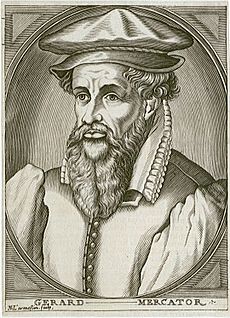
Belgium has a long history of important discoveries in science and technology. Some famous scientists include:
- Gerardus Mercator, who made maps
- Andreas Vesalius, who studied the human body
- Rembert Dodoens, who studied plants and medicine
- Simon Stevin, a mathematician
In the 1860s, chemist Ernest Solvay and engineer Zenobe Gramme made important inventions. Solvay developed a process for making soda ash. Gramme invented a type of electric generator. Later, Leo Baekeland created Bakelite, an early plastic, around 1907-1909.
A major scientific idea came from Belgian scientist Georges Lemaître. In 1927, he proposed the Big Bang theory. This theory explains how the universe began.
Several Belgians have won Nobel Prizes for their work in medicine:
- Jules Bordet in 1919
- Corneille Heymans in 1938
- Albert Claude and Christian De Duve in 1974
Ilya Prigogine won the Nobel Prize in Chemistry in 1977. Two Belgian mathematicians, Pierre Deligne (1978) and Jean Bourgain (1994), have won the Fields Medal. This is a top award for mathematicians.
Culture
Fine Arts and Architecture
Belgium has made many contributions to painting and architecture. Several important buildings in Belgium are on UNESCO's World Heritage List.
In the 15th century, religious paintings by Jan van Eyck and Rogier van der Weyden were very important. In the 16th century, artists like Peter Breughel painted landscapes. The style of Peter Paul Rubens and Anthony van Dyck was popular in the early 17th century.
In the 19th and 20th centuries, many unique Belgian painters emerged. These included romantic, expressionist, and surrealist artists. Famous names include James Ensor, Constant Permeke, Paul Delvaux, and René Magritte. Modern artists like Panamarenko, Jan Fabre, and Luc Tuymans are also well-known.
Belgian architects also made their mark in the 19th and 20th centuries. Victor Horta and Henry van de Velde were key figures in starting the Art Nouveau style.
Music and Literature
Belgium has produced many famous musicians. In the 19th and 20th centuries, violinists like Henri Vieuxtemps and Eugène Ysaÿe were well-known. Adolphe Sax invented the saxophone in 1846. The composer César Franck was born in Liège in 1822.
More recently, jazz musician Toots Thielemans and singer Jacques Brel became famous worldwide. In rock and pop music, bands like Telex, K's Choice, and Hooverphonic are well-known.
Belgium has several famous authors. These include poets like Emile Verhaeren and novelists like Georges Simenon. The poet and playwright Maurice Maeterlinck won the Nobel Prize in Literature in 1911.
Belgian comics are also very famous. The Adventures of Tintin by Hergé is one of the most popular comics in the world. Other great comic artists like Peyo (who created The Smurfs) and André Franquin helped make Belgian comics known globally.
Belgian cinema has also created many successful films. Directors like the Dardenne brothers are well-known.
Cuisine
Belgium is famous for its delicious food and drinks. These include beer, chocolate, waffles, and french fries. Did you know that french fries were actually invented in Belgium?
The national dishes are "steak and fries with salad" and "mussels with fries". Other popular fast foods include the Mitraillette.
Belgian chocolate and pralines are known worldwide. Brands like Côte d'Or, Guylian, and Leonidas are very popular. Belgium also makes over 1100 different kinds of beer! The Trappist beer from the Westvleteren Brewery has often been called the best beer in the world. The world's largest brewing company, Anheuser-Busch InBev, is based in Leuven, Belgium.
Sports
Since the 1970s, sports clubs in Belgium are often organized by language group. Association football (soccer) is one of the most popular sports. Cycling, tennis, swimming, and judo are also very popular.
Belgian cyclist Eddy Merckx is considered one of the greatest cyclists ever. He won the Tour de France five times. Jean-Marie Pfaff, a former Belgian goalkeeper, is also seen as one of the best in football history.
Belgium and the Netherlands hosted the UEFA European Football Championship in 2000. Belgium also hosted the tournament in 1972.
In tennis, Kim Clijsters and Justine Henin were both named Player of the Year in women's tennis. The Spa-Francorchamps motor-racing track hosts the Formula One World Championship Belgian Grand Prix. Belgian driver Jacky Ickx won many races, including the 24 Hours of Le Mans six times. Belgium is also known for its strong motocross riders.
Each year, Belgium hosts several major sporting events. These include the Memorial Van Damme athletics competition and classic cycling races like the Tour of Flanders. The 1920 Summer Olympics were held in Antwerp.
Related pages
Images for kids
-
Gallia Belgica during Julius Caesar's conquest of Gaul in 54 BCE.
-
The Burgundian State of Charles the Bold in the 15th century.
-
Crowds cheering for British troops entering Brussels, 4 September 1944.
-
Bilingual signs in Brussels.
-
National Basilica of the Sacred Heart in Koekelberg, Brussels.
-
Jacques Brel, a famous Belgian singer.
-
The Gilles of Binche, in costume, wearing wax masks.
-
Moules-frites or mosselen met friet is a popular dish in Belgium.
-
Eddy Merckx, one of the greatest cyclists of all time.
See also
 In Spanish: Bélgica para niños
In Spanish: Bélgica para niños


